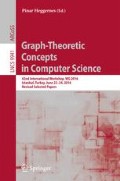Abstract
A linear ordering of the vertices of a graph G separates two edges of G if both the endpoints of one precede both the endpoints of the other in the order. We call two edges \(\{a,b\}\) and \(\{c,d\}\) of G strongly independent if the set of endpoints \(\{a,b,c,d\}\) induces a \(2K_2\) in G. The induced separation dimension of a graph G is the smallest cardinality of a family \(\mathcal {L}\) of linear orders of V(G) such that every pair of strongly independent edges in G are separated in at least one of the linear orders in \(\mathcal {L}\). For each \(k \in \mathbb {N}\), the family of graphs with induced separation dimension at most k is denoted by \({\text {ISD}}(k)\).
In this article, we initiate a study of this new dimensional parameter. The class \({\text {ISD}}(1)\) or, equivalently, the family of graphs which can be embedded on a line so that every pair of strongly independent edges are disjoint line segments, is already an interesting case. On the positive side, we give characterizations for chordal graphs in \({\text {ISD}}(1)\) which immediately lead to a polynomial time algorithm which determines the induced separation dimension of chordal graphs. On the negative side, we show that the recognition problem for \({\text {ISD}}(1)\) is NP-complete for general graphs. We then briefly study \({\text {ISD}}(2)\) and show that it contains many important graph classes like outerplanar graphs, chordal graphs, circular arc graphs and polygon-circle graphs. Finally, we describe two techniques to construct graphs with large induced separation dimension. The first one is used to show that the maximum induced separation dimension of a graph on n vertices is \(\varTheta (\lg n)\) and the second one is used to construct AT-free graphs with arbitrarily large induced separation dimension.
Access this chapter
Tax calculation will be finalised at checkout
Purchases are for personal use only
References
Alon, N., Basavaraju, M., Chandran, L.S., Mathew, R., Rajendraprasad, D.: Separation dimension of bounded degree graphs. SIAM J. Discrete Math. 29(1), 59–64 (2015)
Basavaraju, M., Chandran, L.S., Golumbic, M.C., Mathew, R., Rajendraprasad, D.: Boxicity and separation dimension. In: Kratsch, D., Todinca, I. (eds.) WG 2014. LNCS, vol. 8747, pp. 81–92. Springer, Heidelberg (2014)
Basavaraju, M., Chandran, L.S., Golumbic, M.C., Mathew, R., Rajendraprasad, D.: Separation dimension of graphs and hypergraphs. Algorithmica 75, 187–204 (2015)
Brandstädt, A., Le, V.B., Spinrad, J.P.: Graph Classes: A Survey. SIAM, Philadelphia (1999)
Broersma, H., Patel, V., Pyatkin, A.: On toughness and Hamiltonicity of \(2K_2\)-free graphs. J. Graph Theor. 75(3), 244–255 (2014)
Chung, F.R.K., Gyárfás, A., Tuza, Z., Trotter, W.T.: The maximum number of edges in \(2K_2\)-free graphs of bounded degree. Discrete Math. 81(2), 129–135 (1990)
Chvátal, V., Hammer, P.L.: Aggregation of inequalities in integer programming. Ann. Discret. Math. 1, 145–162 (1977)
Corneil, D.G., Stacho, J.: Vertex ordering characterizations of graphs of bounded asteroidal number. J. Graph Theor. 78(1), 61–79 (2015)
Eaton, N., Faubert, G.: Caterpillar tolerance representations. Bull. Inst. Comb. Appl. 64, 109–117 (2012)
Fishburn, P.C., Trotter, W.T.: Dimensions of hypergraphs. J. Comb. Theor. Ser. B 56(2), 278–295 (1992)
Gavril, F.: Maximum weight independent sets and cliques in intersection graphs of filaments. Inf. Process. Lett. 73(5), 181–188 (2000)
Golumbic, M.C.: Algorithmic Graph Theory and Perfect Graphs. Elsevier, Amsterdam (2004)
Golumbic, M.C., Trenk, A.N.: Tolerance Graphs. Cambridge University Press, Cambridge (2004)
Habib, M., Paul, C., Telle, J.A.: A linear-time algorithm for recognition of catval graphs. In: Eurocomb 2003: European Conference on Combinatorics, Graphs Theory and Applications (2003)
Lovász, L.: Coverings and colorings of hypergraphs. In Proceedings of the 4th Southeastern Conference on Combinatorics, Graph Theory, and Computing, pp. 3–12. Utilitas Mathematica Publishing, Winnipeg (1973)
Lozin, V.V., Mosca, R.: Independent sets in extensions of \(2K_2\)-free graphs. Discrete Appl. Math. 146(1), 74–80 (2005)
Mycielski, J.: Sur le coloriage des graphes. Colloq. Math. 3, 161–162 (1955)
Roberts, F.S.: On the boxicity and cubicity of a graph. In: Recent Progresses in Combinatorics, pp. 301–310. Academic Press, New York (1969)
Telle, J.A.: Tree-decompositions of small pathwidth. Discrete Appl. Math. 145(2), 210–218 (2005)
Author information
Authors and Affiliations
Corresponding author
Editor information
Editors and Affiliations
Rights and permissions
Copyright information
© 2016 Springer-Verlag GmbH Germany
About this paper
Cite this paper
Ziedan, E., Rajendraprasad, D., Mathew, R., Golumbic, M.C., Dusart, J. (2016). Induced Separation Dimension. In: Heggernes, P. (eds) Graph-Theoretic Concepts in Computer Science. WG 2016. Lecture Notes in Computer Science(), vol 9941. Springer, Berlin, Heidelberg. https://doi.org/10.1007/978-3-662-53536-3_11
Download citation
DOI: https://doi.org/10.1007/978-3-662-53536-3_11
Published:
Publisher Name: Springer, Berlin, Heidelberg
Print ISBN: 978-3-662-53535-6
Online ISBN: 978-3-662-53536-3
eBook Packages: Computer ScienceComputer Science (R0)

